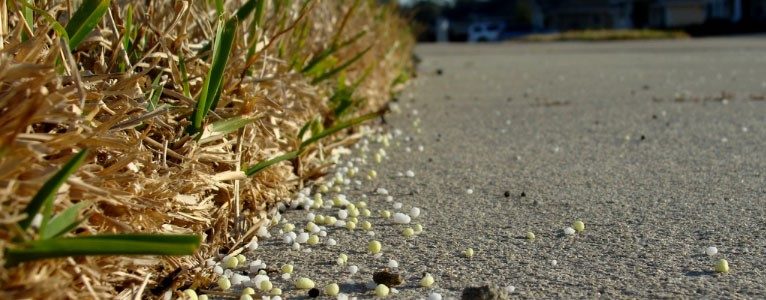Eagle Mountain residents are asked to stop fertilizing their lawns beginning Nov. 15 and not resume fertilizing until March 1.
Larry Diamond, storm drain supervisor for Eagle Mountain City, explains the dangers of fertilizing lawns during this time of year.
“The lawn is not going to use the fertilizer,” says Diamond of the cold weather seasons. “It’s just going to all flow downstream and then go down into the Tickville Wash where it eventually makes its way into the lake.”
If a resident fertilizes during the winter when the ground is hard or frozen, the lawn will not gain any nutrients, according to Diamond. Instead, the fertilizer will be washed into storm drains by wind and snow which can have a detrimental impact on wildlife and water quality.
Experts have identified that among the primary culprits of harmful algal blooms plaguing Utah Lake are Nitrogen and Phosphorus, the two main ingredients in common lawn fertilizer.
“Stormwater runoff and groundwater leaching can carry excess fertilizer into our waterways and eventually into the rivers and lakes,” says Diamond. “Once there, the nutrients in fertilizer support the excessive growth of phytoplankton and algae in the lakes.”
According to Diamond, this process is called “eutrophication.”
Eutrophication can negatively impact the lake’s ecosystem in many ways by creating low dissolved oxygen conditions, making the water more turbid, leading to declines in seagrass and changing the types of animals and plants that inhabit the waters.
The Utah Department of Environmental Quality (UDEQ) detected harmful algae in pockets of high concentration at several locales around Utah Lake. Recreationists are discouraged from swimming, water skiing, or even boating in these areas.
According to UDEQ, toxins produced by harmful algal blooms can lead to gastrointestinal illness, skin irritation, or even liver, neurological, or respiratory problems in extreme cases.
Harmful algal blooms typically occur in late summer and early fall when recreationists are still enjoying the water and can therefore be considered a threat to health and safety.
By avoiding fertilizing in the fall and winter, Eagle Mountain residents can help prevent algal blooms in Utah Lake during peak recreation seasons.
Diamond says that the City’s Storm Water department has plans to track the nitrogen and phosphorus and the total amount of dissolved solids that find their way into Tickville Wash so they can see exactly how much pollution Eagle Mountain contributes to the lake.
The Storm Water department will use this information to adjust its public outreach & education efforts to best suit the needs of the community.
In addition to ceasing fertilization during the colder months, Eagle Mountain residents can also help reduce the city’s impact on lake pollution by fertilizing responsibly during the spring and summer.
“Any fertilizer that’s landed in hard landscapes, like on the road and concrete and on the sidewalk, the driveways, should be swept up and disposed of,” explains Diamond.
Fertilizer that is left on the sidewalk, or in the road, can be easily washed down the storm drain. For this reason, Diamond also discourages residents from fertilizing during, or before, heavy rainfall.
“That also creates sheet flow and then will just run all the fertilizer off into the storm drain system and then dump it into the Tickville Wash and surrounding bodies of water,” says Diamond.
Fertilizing during the winter is also not in a resident’s best financial interest.
Since the ground is too hard for the lawn to gain benefits from the fertilizer, residents are not only flushing harmful chemicals down the storm drains, but the cost associated with it as well.


